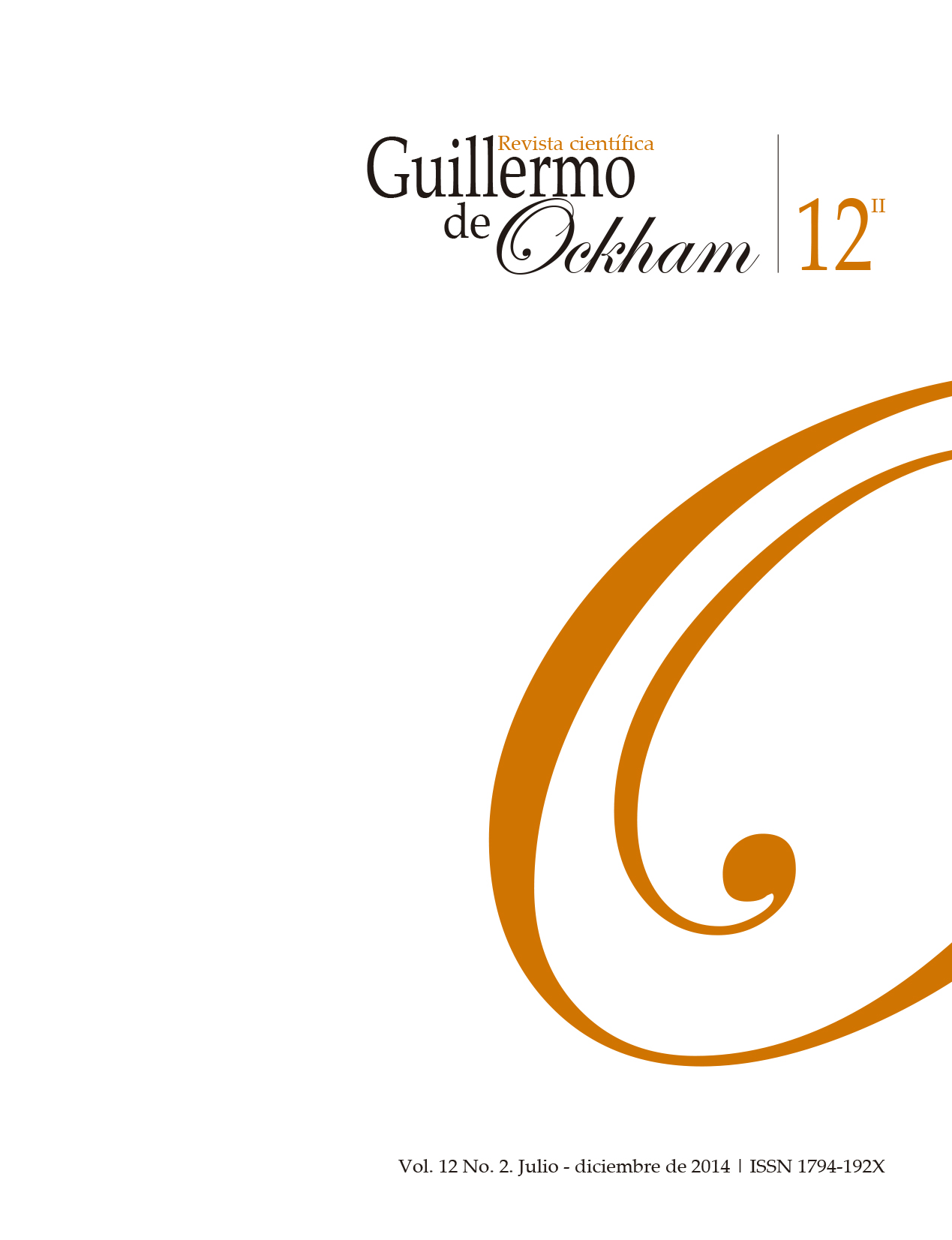The Revista Guillermo de Ockham provides an immediate and open access to its content, based on the principle of offering the public a free access to investigations to provide a global interchange of knowledge.
Unless otherwise established, the contents of this journal has a license with Creative Commons Attribution-NonCommercial-NoDerivatives 4.0 International (CC BY-NC-ND 4.0) http://creativecommons.org/licenses/by-nc-nd/4.0/
- Attribution: You must give appropriate credit, provide a link to the license, and indicate if changes were made. You may do so in any reasonable manner, but not in any way that suggests the licensor endorses you or your use.
- NonCommercial: You may not use the material for commercial purposes.
- NoDerivatives: If you remix, transform, or build upon the material, you may not distribute the modified material.
- No additional restrictions: You may not apply legal terms or technological measures that legally restrict others from doing anything the license permits.
Abstract
Este artículo presenta los resultados de un estudio piloto sobre la relación entre comprensión humorística y comprensión causal en la primera infancia. A veinte niños entre los tres y los cinco años, les fueron presentados ocho chistes gráficos con incongruencias posibles e imposibles. Los resultados mostraron que al escoger entre tres opciones: incongruente, congruente y neutra para componer la imagen que les pareciera más graciosa, la mayoría de los niños eligió la alternativa incongruente. El análisis de la producción verbal mostró que la incongruencia disparó más funcionamientos cognitivos de alto orden que las otras dos opciones. Adicionalmente, los niños ofrecieron razones para explicar las incongruencias posibles y tendieron a rechazar las violaciones imposibles, ofreciendo en ocasiones, alternativas para “ajustar” la situación a la regularidad física. Los resultados sugieren que el chiste gráfico constituye un recurso metodológico apropiado para explorar los funcionamientos cognitivos de los niños pequeños y las relaciones entre su comprensión humorística y su comprensión causal.
References
Baillargeon, R. (1994). How do infants learn about the physical world? Current Directions in Psychological Science, 3(5), 133-140. doi:10.1111/1467-8721.ep10770614
Bariaud, F. (1988). Age differences in children’s humor. Journal of Children in Contemporary Society, 20, 15-45. doi:10.1300/J274v20n01_03
Bergson, H. (1953). La risa: ensayo sobre la significación de lo cómico. Buenos Aires: Losada.
Berlyne, D. E. (1969). Laughter, humor, and play. En G. Lindzey, & E. Aronson, (Eds.), The handbook of social psychology (2nd ed., Vol. 3, pp. 795-852). Reading, MA: Addison-Wesley.
Boden, M. A. (1990). The creative mind: Myths and mechanisms. London: Routledge.
Brewer, W. F., Chinn, C. A., & Samarapungavan, A. (2000). Explanation in scientists and children. En F. C. Keil & R. A. Wilson (Eds.), Explanation and cognition (pp. 279-298). Cambridge, MA: The MIT Press.
Bruner, J. S., & Postman, L. (1949). On the perception of incongruity: A paradigm. Journal of Personality, 18(2), 206-223. doi:10.1111/j.1467-6494.1949.tb01241.x
Carlson, K. A. (2011). The impact of humor on memory: Is the humor effect about humor? Humor: International Journal of Humor Research, 24, 21-41. doi:10.1515/humr.2011.002
Chapman, A. J., & Crompton, P. (1978). Humorous presentations of material and presentations of humorous material: A review of the humor and memory literature and two experimental studies. En M. M. Gruneber, P. E. Morris & R. N. Sikes (Eds.), Practical aspects of memory (pp. 84-92). London: Academic Press.
Chinn, C. A., & Brewer, W. F. (1993). The role of anomalous data in knowledge acquisition: A theoretical framework and implications for science instruction. Review of Educational Research, 63, 1-49. doi:10.3102/00346543063001001
Chinn, C. A., & Brewer, W. F. (2001). Models of data: A theory of how people evaluate data. Cognition and Instruction, 19, 323-393. doi:10.1207/S1532690XCI1903_3
Chinn, C. A., & Malhotra, B. A. (2002). Children's responses to anomalous scientific data: How is conceptual change impeded? Journal of Educational Psychology, 94, 327-343. doi:10.1037//0022-0663.94.2.327
DeLoache, J. S., Miller, K. F., & Pierroutsakos, S. L. (1998). Reasoning and problem solving. En D. Kuhn & R. Siegler (Eds.), Handbook of child psychology, 5th Edition, Vol. 2: Cognition, perception, and language (pp. 801-850). NY: Wiley.
De Mey, T. (2005). Tales of the unexpected: Incongruity-resolution in humor comprehension, scientific discovery and thought experimentation. Logic and Logical Philosophy, 14, 69-88. doi:10.12775/LLP.2005.006
Dewey, J. (1998). Cómo pensamos: nueva exposición de la relación entre pensamiento reflexivo y proceso educativo. Barcelona: Paidós.
Dixon, J. A., & Kelley, E. (2007). Theory revision and redescription: Complementary processes in knowledge acquisition. Current Directions in Psychological Science, 16, 111-115. doi:10.1111/j.1467-8721.2007.00486.x
Duckworth, E. (2000). Cuando surgen ideas maravillosas y otros ensayos sobre la enseñanza y el aprendizaje. Barcelona: Gedisa.
Faw, T. T. & Wingard, J. A. (1977). Relation between conceptual development and visual exploration of incongruity. Developmental Psychology, 13, 137-142. doi:10.1037/0012-1649.13.2.137
Forabosco, G. (1992). Cognitive aspects of the humor process: The concept of incongruity. Humor: International Journal of Humor Research, 5, 45-68. doi:10.1515/humr.1992.5.1-2.45
Forabosco, G. (2008). Is the concept of incongruity still a useful construct for the advancement of humor research? Lodz Papers in Pragmatics, 4(1), 45-62. doi:10.2478/v10016-008-0003-5
Freud, S. (1986). Sigmund Freud-Obras completas: El chiste y su relación con lo inconsciente (Vol. 8). Buenos Aires: Amorrortu Editores.
Guo, J., Zhang, X., Wang, Y., & Xeromeritou, A. (2011). Humour among Chinese and Greek preschool children in relation to cognitive development. International Electronic Journal of Elementary Education, 3(3), 153-170.
Hempelmann, C. F., & Samson, A. C. (2008). Cartoons: Drawn jokes? En V. Raskin (Ed.), The primer of humor research (pp. 609-640). Berlin: Mouton de Gruyter.
Huber, O., & Leder, H. (1997). Are more compact cartoons more humorous? Humor: International Journal of Humor Research, 10, 91-103. doi:10.1515/humr.1997.10.1.91
Jirout, J., & Klahr, D. (2012). Children’s scientific curiosity: In search of an operational definition of an elusive concept. Developmental Review, 32, 125-160. doi:10.1016/j.dr.2012.04.002
Karmiloff-Smith, A. (1988). The child is a theoretician, not an inductivist. Mind & Language, 3, 183-195. doi:10.1111/j.1468-0017.1988.tb00142.x
Karmiloff-Smith, A., & Inhelder, B. (1975). If you want to get ahead, get a theory. Cognition, 3,195-212. doi:10.1016/0010-0277(74)90008-0
Klahr, D. (2000). Exploring science: The cognition and development of discovery processes. Cambridge, MA: The MIT Press.
Klein, A. (1987). Children´s humor: A cognitive developmental perspective. En L. G. Katz (Ed.), Current topics in early childhood education (Vol. 7, pp. 126-149). Norwood, NJ: Ablex.
Koestler, A. (1964). The act of creation. London: Hutchinson.
Loizou, E. (2005). Humour: A different kind of play. European Early Childhood Education Research Journal, 13, 97-109. doi:10.1080/13502930585209701.
Loizou, E. (2006). Young children’s explanation of pictorial humor. Early Childhood Education Journal, 33, 425-431. doi:10.1007/s10643-005-0053-z
Loizou, E. (2008). Children's humour: A revised theoretical framework. En P. G. Grotewell & Y. R. Burton (Eds.), Early childhood education: Issues and developments (pp. 189-209) NY: Nova Science.
Martin, R. A. (2007). The psychology of humor: An integrative approach. San Diego, CA: Elsevier Academic Press.
Mayes, L. C., Klin, A., & Cohen, D. J. (1994). The effect of humor on children's developing theory of mind. British Journal of Developmental Psychology, 12, 555-561. doi:10.1111/j.2044-835X.1994.tb00655.x
McGhee, P. E. (1971a). Development of the humor response: A review of the literature. Psychological Bulletin, 76, 328-348. doi:10.1037/h0031670
McGhee, P. E. (1971b). The role of operational thinking in children's comprehension and appreciation of humor. Child Development, 42, 733-744. doi:10.2307/1127444
McGhee, P. E. (1971c). Cognitive development and children's comprehension of humor. Child Development, 42, 123-138. doi:10.2307/1127069
McGhee, P. E. (1974). Cognitive mastery and children's humor. Psychological Bulletin, 81, 721-730. doi:10.1037/h0037015
McGhee, P. E. (1976). Children's appreciation of humor: A test of the cognitive congruency principle. Child Development, 47, 420-426. doi:10.2307/1128797
McGhee, P. E. (1979). Humor: Its origin and development. San Francisco, CA: W. H. Freeman.
McGhee, P. E., & Chapman, A. J. (1980). Children's humour. Chichester, UK: Wiley.
McGhee, P. E., & Panoutsopoulou, T. (2009). The role of cognitive factors in children’s metaphor and humor comprehension. Humor: International Journal of Humor Research, 3, 379-402. doi:10.1515/humr.1990.3.4.379
Morris, B. J., Croker, S., Masnick, A. M., & Zimmerman, C. (2012). The emergence of scientific reasoning. En H. Kloos, B. J. Morris & J. L. Amaral (Eds.), Current topics in children's learning and cognition (pp. 61-82). Rijeka, Croatia: InTech
Newell, A., & Simon, H. A. (1972). Human problem solving. Englewood Cliffs, NJ: Prentice-Hall.
Ordoñez, O., & Hernández, E. (1996). Comprensión de la historieta humorística en niños de 2 a 4 años en dos contextos culturales diferentes. Estudio exploratorio. (Trabajo de grado, Universidad del Valle, Cali, Colombia).
Paulos, J. A. (1980). Mathematics and humor. Chicago, IL: The University of Chicago Press.
Pollock, J. (2003). ¿Qué es el humor? Buenos Aires: Paidós.
Puche-Navarro, R. (2001). Mutaciones, metáforas y humor visual en el niño. En R. Rosas (Ed.), La mente reconsiderada: en homenaje a Angel Rivière (pp. 181-202). Santiago de Chile: Psykhe.
Puche-Navarro, R. (2004). Graphic jokes and children's mind: An unusual way to approach children's representational activity. Scandinavian Journal of Psychology, 45, 343-355. doi:10.1111/j.1467-9450.2004.00414.x
Puche-Navarro, R. (2009). From implicit to explicit representation in children's response to pictorial humor. International Journal of Behavioral Development, 33, 543-555. doi:10.1177/0165025409343755
Puche-Navarro, R., Combariza, E., & Ossa, J. C. (2012). La naturaleza no lineal de los funcionamientos inferenciales: Un estudio empírico con base en el humor gráfico. Avances en Psicología Latinoamericana, 30, 27-38.
Puche-Navarro, R., & Lozano, H. (1998). Paradigma y sintagma: chiste gráfico y tira cómica. Un estudio experimental. Infancia y Aprendizaje, 84, 99-113. doi:10.1174/021037098760378810
Puche-Navarro, R., & Lozano, H. (2002). El sentido del humor en el niño: estudio empírico. Bogotá, Colombia: Siglo del Hombre.
Puche-Navarro, R., Torrado, M. C., & Ordoñez, O. (2002). El desarrollo representacional: ¿Un metachiste? Elementos para una discusión. En R. Puche-Navarro. & H. Lozano (Eds.), El sentido del humor en el niño: estudio empírico (pp. 137-161). Bogotá, Colombia: Siglo del Hombre.
Raskin, V. (2008a). The primer of humor research. Berlin: Mouton de Gruyter.
Raskin, V. (2008b). Theory of humor and practice of humor research: Editor’s notes and thoughts. En V. Raskin (Ed.), The primer of humor research (pp. 1-15). Berlin: Mouton de Gruyter.
Reisenzein, R. (2000). The subjective experience of surprise. En H. Bless & J. P. Forgas (Eds.), The message within: The role of subjective experience in social cognition and behavior (pp. 262-279). Philadelphia, PA: Psychology Press.
Rothbart, M. K., & Pien, D. (1977). Elephants and marshmallows: A theoretical synthesis of incongruity resolution and arousal theories of humour (pp. 37-40). En A. J. Chapman & H. C. Foot (Eds.), It’s a funny thing, humour Elmsford, NY: Pergamon.
Roncancio, M., & Puche-Navarro, R. (2012). Humor gráfico y comprensión de deseos. Diversitas- Perspectivas en Psicología, 8, 345-360.
Ruch, W. (2008). The psychology of humor. En V. Raskin (Ed.), The primer of humor research (pp. 17-100). Berlin: Mouton de Gruyter.
Ruffman, T., Perner, J., Olson, D., & Doherty, D. (1993). Reflecting on scientific thinking: Children's understanding of the hypothesis-evidence relation. Child Development, 64, 1617-1636. doi:10.1111/j.1467-8624.1993.tb04203.x
Samson, A. C. (2012). The influence of empathizing and systemizing on humor processing: Theory of Mind and humor. Humor: International Journal of Humor Research, 25, 75-98. doi:10.1515/HUMR.2012.005
Schmidt, S. R. (1994). Effects of humor on sentence memory. Journal of Experimental Psychology: Learning, Memory & Cognition, 20, 953-967. doi:10.1037/0278-7393.20.4.953
Schmidt, S. R. (2002). The humour effect: Differential processing and privileged retrieval. Memory, 10, 127-138. doi:10.1080/09658210143000263
Schmidt, S. R., & Williams, A. R. (2001). Memory for humorous cartoons. Memory & Cognition, 29, 305-311. doi:10.3758/BF03194924
Schützwohl, A., & Reisenzein, R. (1999). Children's and adults' reactions to a schema-discrepant event: A developmental analysis of surprise. International Journal of Behavioral Development, 23, 37-62. doi:10.1080/016502599383991
Shultz, T. R. (1972). The role of incongruity and resolution in children’s appreciation of cartoon humour. Journal of Experimental Child Psychology, 13, 456-477. doi:10.1016/0022-0965(72)90074-4
Shultz, T. R. (1974). Development of the appreciation of riddles. Child Development, 45, 100-105. doi:10.2307/1127755
Shultz, T. R. (1976). A cognitive-developmental analysis of humor. En A. H. Chapman &
H. C. Foot (Eds.), Humour and laughter: Theory, research and application (pp. 11-36). London: Wiley.
Shultz, T. R. & Horibe, F. (1974). Development of the appreciation of verbal jokes. Developmental Psychology, 10, 13-20. doi:10.1037/h0035549
Sigel, I. E. (1997). Modelo de distanciamiento y desarrollo de la competencia representativa. Infancia y Aprendizaje, 78, 13-29. doi:10.1174/021037097761403118
Sigel, I. E. (2002). The psychological distancing model: A study of the socialization of cognition. Culture & Psychology, 8, 189-214. doi:10.1177/1354067X02008002438
Sodian, B., Zaitchik, D., & Carey, S. (1991). Young children´s differentiation of hypothetical beliefs from evidence. Child Development, 62, 753-766. doi:10.1111/j.1467-8624.1991.tb01567.x
Stiensmeier-Pelster, J., Martini, A., & Reisenzein, R. (1995). The role of surprise in the attribution process. Cognition and Emotion, 9, 5-31. doi:10.1080/02699939508408963
Strick, M., Holland, R. W., van Baaren, R., & van Knippenberg, A. (2010). Humor in the eye tracker: Attention capture and distraction from context cues. The Journal of General Psychology, 137, 37-48. doi:10.1080/00221300903293055
Suls, J. M. (1972). A two-stage model for the appreciation of jokes and cartoons. En J. H. Goldstein & P. E. McGhee (Eds.), The psychology of humor. NY: Academic Press.
Suls, J. M. (1983). Cognitive processes in humor appreciation. En P. E. McGhee & J. H. Goldstein (Eds.), Handbook of humor research, Vol. 1: Basic issues (pp. 39-57). NY: Springer-Verlag.
Takahashi, M., & Inoue, T. (2009). The effects of humor on memory for non- sensical pictures. Acta Psychologica, 132, 80-84. doi:10.1016/j.actpsy.2009.06.001
Thornton, S. (1998). La resolución infantil de problemas. Madrid: Morata.
Whitt, J. K., & Prentice, N. M. (1977). Cognitive processes in the development of children's enjoyment and comprehension of joking riddles. Developmental Psychology, 13, 129-136. doi:10.1037/0012-1649.13.2.129
Zigler, E., Levine, J., & Gould, L. (1966). Cognitive processes in the development of children's appreciation of humor. Child Development, 37, 507-518. doi:10.2307/1126675
Zillmann, D., Masland, J. L., Weaver, J. B., Lacey, L. A., Jacobs, N. E., Dow, J. H., Klein, C. A., & Banker, S. R. (1984). Effects of humorous distortions on children's learning from educational television. Journal of Educational Psychology, 76, 802-812. doi:10.1037/0022-0663.76.5.802
Ziv, A. (1976). Facilitating effects of humor on creativity. Journal of Educational Psychology, 68, 318-322. doi:10.1037/0022-0663.68.3.318
Ziv, A. (1983). The influence of humorous atmosphere on divergent thinking. Contemporary Educational Psychology, 8, 68-75. doi:10.1016/0361-476X(83)90035-8
































